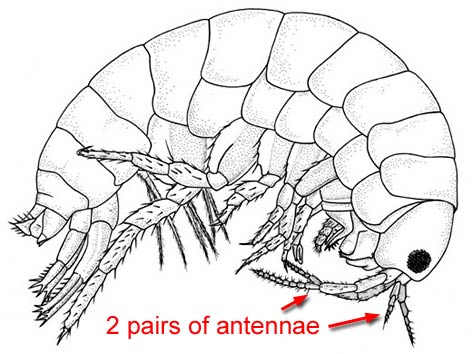- Amphipoda
-

Common names: beach hoppers, litter hoppers
Probability of encounter: low
Quarantine importance: no known importance.
Similarity to mites: none.
Morphology
Normal adult length:
1-1.5 cm
Body tagmata: head (2 pairs of antennae), thorax (7 pairs of legs),
abdomen (3 pairs of uropods)
Eyes: compound lateral
Antennae: biramous, flagellate, flagellum with many small segments;
antennules 1/2 length of antennae
Mouthparts: mandibles without palps; two pairs of maxillae
Legs: 7 thoracic pairs, 1st pair may be pincer-like
Respiration: thoracic gills
Gonopore: posterior thoracic segments
Distinguishing features: laterally compressed; two pairs of antennae;
7 pairs of legs and 3 pairs of uropods
Comments:
Amphipods are laterally compressed and curl ventrally. Two pairs of biramous
antennae are present, and one pair (antennules) are about half the length
of the other. The mandibles lack palps. The thorax has 7 pairs of legs and
the abdomen has slender pleopods and three pairs of distal uropods, the last
of which has a single segment (+/- a minute ramus).
Diversity: ca. 6000 species, but only one family (Talitridae) that has fully terrestrial species.
References
Trueman JWH and Dimitriadis
S. (1999). Key to families of Australian aquatic Crustacea, in, An Interactive
Guide to Australian Aquatic Invertebrates. Windows Edition 2. CSIRO Publishing,
Collingwood, Victoria (LucID CD-ROM interactive key).
Williams WD. 1980. Australian Freshwater Life: The Invertebrates of Australian
Inland Waters. Macmillian: Melbourne